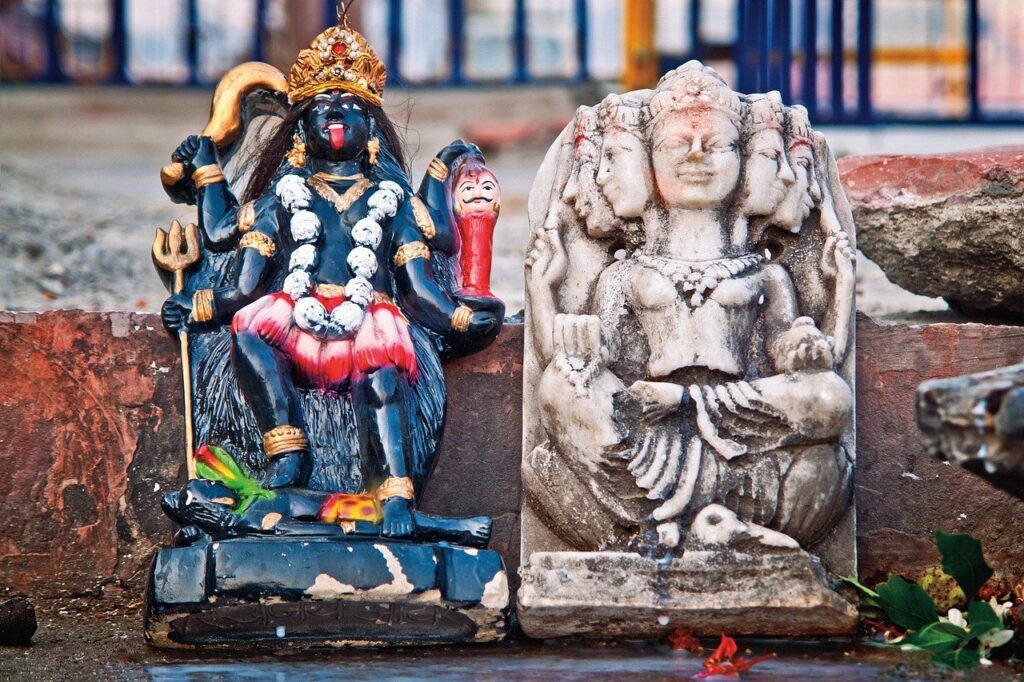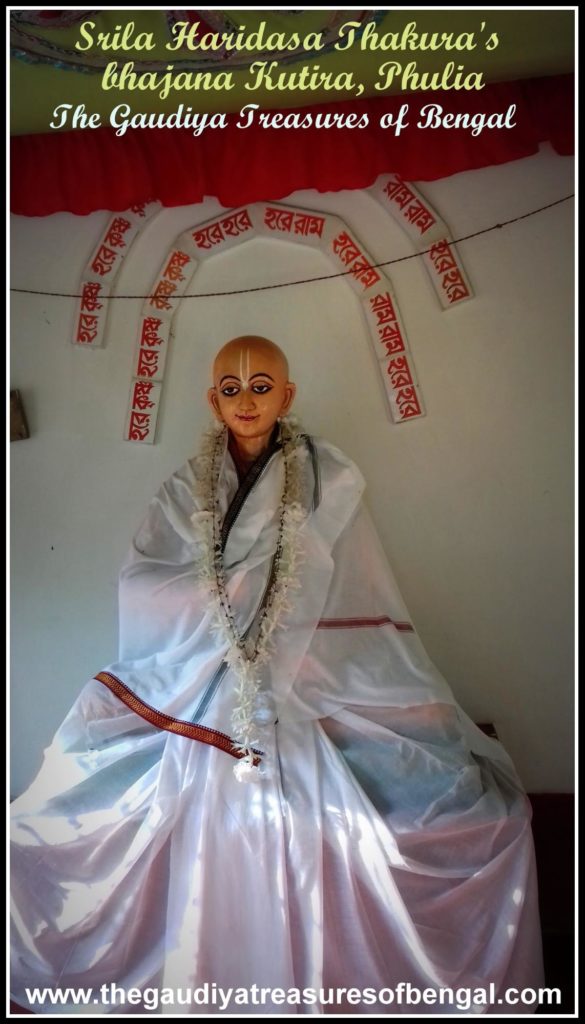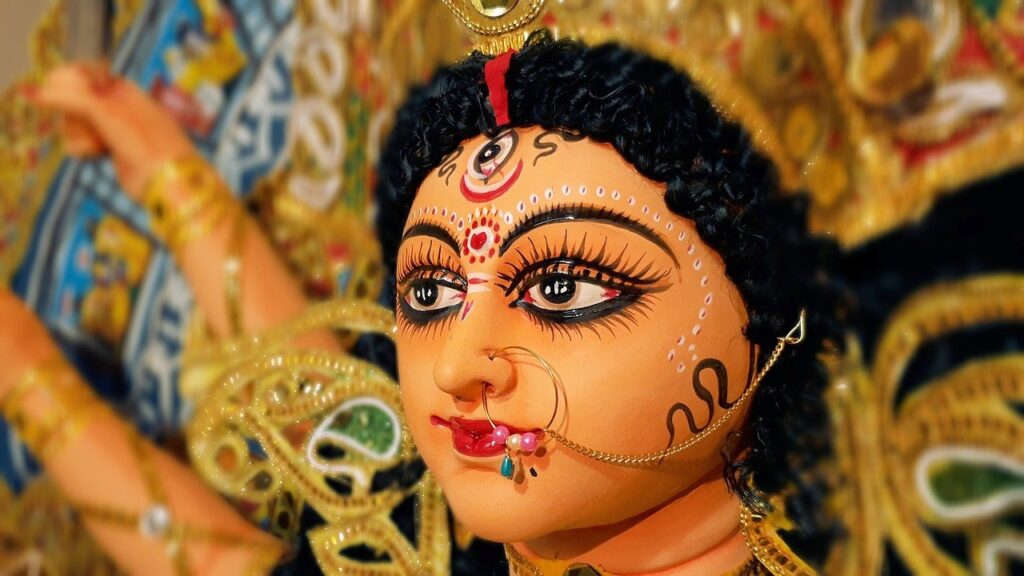#1 Do Vaishnavas worship goddess Durga ?
Many people believe that Vaishnavas do not worship or acknowledge Maa Durga (Mahamaya shakti), but this is a completely mistaken notion. It is true however that how the dry philosophers and the impersonalists worship Mahamaya devi is contrary to how the Vaishnavas do the same. The Vaishnavas hold that devi Durga is a devotee of the Supreme Lord Sri Krishna. It is recorded in scriptures like Srimad Bhagavatam, Vishnu Purana, etc how on being instructed by the Supreme Lord, she appeared from the womb of mother Yashoda who was imprisoned by Kamsa and apprised Kamsa of his imminent death at the hands of Gokulananda Krishna. Kali, Durga, Chandi, Annapurna, Katyayani, etc are different names by which Mahamaya devi is often called upon. She is responsible for executing the will of the Supreme Lord and is deemed worshipable by the Vaishnavas.
mayadhyaksena prakritih
suyate sa-characaram
hetunanena kaunteya
jagad viparivartate
(Bhagavad Gita 9.10)
–
O son of Kunti, this material nature, which is one of My energies, is working under My command thereby producing all moving and nonmoving beings. Under its rule, this manifestation is created and annihilated again and again.
#2 Energy (Shakti) and the energetic (Shaktiman)
The energy of the Supreme Lord manifests itself in different modes in different realms. On the Suddha-sattva (purely transcendental) platform, this same energy of the Lord manifests itself as Yoga-Maya. This is the internal potency of the Supreme Lord and is represented by Subhadra or sister of Lord Krishna. The name Subhadra means auspicious. So Subhadra devi also paves the way for a devotee’s spiritual progress by furnishing that which is auspicious and taking away all that is inauspicious.
The external energy (Maha-Maya shakti) of the supreme Lord operates in this material realm. She is the shadow of the Lord’s internal potency and is represented by devi Durga.
In one way, there is no distinction between energy and the energetic. Just as heat and light define fire, moonlight characterizes the moon, similarly, energy identifies the energetic. It is not possible to understand the powerful without appreciating his power. The Gautamiya tantra hence exclaims ‘yah Krishna Saiva Durga syad yah Durga Krishna eva sya’ which means that Krishna and His energies are non-different from one another.
Srila Jiva Goswami has stated the following in his Brahma Samhita commentary, ‘Sometimes Goddess Durga is also referred to as the Supreme Controller. This is also correct because there is no difference between Lord Krishna, the master of all powers, and His powers’.
On the other hand, we also have to realize that it is not possible to gain blessings of power unless one also acknowledges the Powerful. If one worships power (energy) and neglects the powerful (energetic), then it is not going to profit him in any way. Energy qualifies the energetic. Energetic is the object while energy is it’s characteristic. Hence, if one does not recognize or worship Krishna (energetic) and only concerns himself/herself with worshiping devi Durga (energy), then it is not very rational of that person. He is yet to attain a complete understanding of the subject matter.
There are differences between energy and the energetic. The energetic may possess various kinds of energy. Energetic is one while energies may be many. Energy is always controlled and administered by the energetic. Energy functions under the direct supervision of the energetic. There cannot be any independent existence of the energy. In other words, energy cannot exist without the energetic.

#3 The ideal mood of worshiping Maa Durga
The Gopis of Vrindavana have exhibited the ideal manner and mood in which devi Katyayani (Durga) should be worshipped. These unmarried girls of Vrindavana were already attracted to Krishna. Hence at the beginning of the Hemanta season (just before the winter), they began worshipping goddess Durga with a vow. After eating Havisyanna (cooked by boiling together moong dal and rice without any spices or turmeric) which is prescribed to purify one’s body before enacting a ritualistic ceremony, they used to daily worship goddess Katyayani early in the morning after taking a bath in the river Yamuna. These gopis used to prepare a deity of the goddess and worship it with sandalwood pulp, garlands, incense, fruits, grains, and twigs of plants. They used to pray to Goddess Katyayani and ask for the benediction that their marriage be fixed with Krishna, the son of Nanda Maharaj. Hence the very purpose of their worship was not to beg for any material blessing but instead to engage themselves in the service of Krishna. This is the ideal mood in which the energy of the Supreme Lord should be worshiped. Likewise, the Vaishnavas pray to goddess Durga and seek her blessings so that they may advance in their Krishna conscious lives.
#4 Serving Krishna satisfies Maa Durga
With regards to worshiping the goddess, it has been mentioned – ‘Archayiya jagadvandan devan Narayanang harim, tadavaran sansthhanan devasya parito-harchayet’ – The other demigods should only be worshiped with the remnants of the paraphernalia (Maha-Prasada) obtained by worshiping Lord Hari, the Supreme Lord.
In other words, energy should never be worshiped separately from the energetic. Devi Durga is a Vaishnavi (devotee of Vishnu) and hence only accepts the Maha-prasada remnants of Lord Vishnu.
Elsewhere the Srimad Bhagavatam explains –
yatha taror mula-nisechanena
tripyanti tat-skandha-bhujopasakhah
pranopaharac ca yathendriyanam
tathaiva sarvarhanam achyutejya
(Srimad Bhagavat, 4.31.14)
–
(Narada said) As pouring water on the root of a tree invigorates the trunk, branches, twigs, and everything else, and as supplying food to the stomach energizes the senses and limbs of the body, similarly, simply worshiping Krishna, the Supreme Personality of Godhead, through devotional service automatically satisfies the demigods, who are parts of that Supreme Personality.
Worshiping the Supreme Lord and engaging in His devotional service is the only means by which one can overcome this vast ocean of material existence and reunite with the Supreme Lord in the spiritual world. Hence Sri Krishna proclaims in Bhagavad Gita –
daivi hy esa guna-mayi
mama maya duratyaya
mam eva ye prapadyante
mayam etam taranti te
(Bhagavad Gita 7.14)
–
This divine energy of Mine, consisting of the three modes of material nature, is very difficult to surmount. But those who have surrendered unto Me (Krishna) can easily cross beyond it.
Pastime – Goddess Durga instructs Govinda Kaviraja to surrender unto Lord Krishna
At the time of Govinda’s birth, Sunanda devi, his mother, suffered from intense labor pain. Damodara Sen, father of Sunanda devi, was a great devotee of Goddess Durga. When Damodara Sen learned about his daughter’s predicament, he prayed to Durga Devi and fed Sunanda the water from Durga yantra. Soon, Sunanda gave birth to a beautiful child who was later named Govinda. Govinda kaviraja grew up to be a staunch devotee of goddess Durga while his brother Ramachandra Kaviraja was a devout vaishnava.
One day while Ramachandra Kaviraja was sitting with his spiritual master Srinivas Acharya at Jajigram (a distant village), a messenger arrived carrying a letter from Govinda kaviraja. In that letter Govinda expressed that he was critically ill and begged his brother Ramachandra, to come and see him at Teliya Budhari (his hometown).
Ramachandra did not want to take leave from his spiritual master and so he hid the letter. A few days later, Govinda wrote a second letter expressing that his health had deteriorated further and wished to see Ramachandra and Srinivasa Acharya.

Actually, Govinda was a staunch devotee of goddess Durga and he prayed to the goddess for her mercy. It is said that he had reached a perfectional stage in his worship of the goddess and had even seen her face to face. So when Govinda asked for liberation from her and requested her to bestow her mercy, so that he could cross over the ocean of birth and death, the goddess instructed him to meditate upon the lotus feet of Lord Krishna instead, if he wished to be delivered. The goddess revealed that she herself mediates upon and worships the reddish feet of the Supreme Lord. Krishna alone can deliver one from the clutches of material birth and death. Maa Durga added that there are hundreds of Durgas, shivas, and Brahmas who are constantly engaged in offering prayers and singing the glories of Lord Krishna. But they are yet to reach the end of the Supreme Lord’s unlimited glories. Only fools refuse to surrender unto Krishna, for He is the supreme controller and the ultimate protector.
Daivat sarire haila grahani asastha
Marana samaya asi haila upanita
Kanthagata prana, svasamatra urdha bahe
Kator haiya ishtadevi prati kahe
Ei to amara haila abasesh kaal
Kripabalokone chhinda samsarera jaal
Akash vanite devi kahe barbar
Govinda smarana kara haibe nistaraTranslation –
Suddenly Govinda’s health began deteriorating severely
It appeared as if the time of his death had arrived
He was suffering tremendously and the only visible symptom of his life was the outflow of his breath
Feeling helpless, he prayed to his worshipable goddess,
‘My last days have now arrived,
Please be merciful upon me and break my attachments with this material world’
Speaking from the sky, the Goddess repeated again and again
‘Contemplate upon Lord Govinda (Krishna) and only then will you achieve liberation from material bondage’
Hearing this, Govinda was left shattered. He could not believe his ears and realized that he had wasted his life not pursuing the path of devotional service unto Lord Krishna. He remembered his brother Ramachandra who was a renowned Vaishnava and wrote to him once more to meet him for the last time.
On receiving this letter, Ramachandra went to Srinivasa Acharya, his spiritual master, and requested him to accept Govinda Kaviraja as his disciple. When he read Govinda’s letter, Srinivasa’s heart softened, and he decided to accompany Ramachandra to Teliya Budhari. Srinivasa arrived and went straight to meet Govinda Kaviraja. Govinda, could not even sit up on his own and was helped by his relatives. Srinivasa Acharya blessed him by placing his lotus feet upon his head. Thereafter Srinivasa bathed and accepted prasadam. His remnants were fed to Govinda Kaviraja. As soon as he honored the remnants, Govinda started to feel better. The next day, Govinda Kaviraja was given a bath, and thereafter Srinivasa Acharya initiated him and whispered the Hare Krishna maha-mantra in his ears. Srinivasa Acharya taught him on how to meditate upon Radha and Krishna and instructed him to read the books composed by the Gosvamis. Govinda gradually regained his strength and thanked Srinivasa for his newly regained life.
Govinda kaviraja lived for thirty-six more years and engaged himself completely in the service of Krishna. Govinda expressed his earnest desire to glorify Lord Krishna and Lord Gauranga through his poems. Srinivasa Acharya happily agreed and blessed him. Govinda Kaviraja’s poems were so powerful and so intense that many addressed him as the second Vidyapati. On the request of King Govinda Harinarayana, he composed a beautiful book dedicated to his brother Ramachandra Kaviraja. The book was named ‘Sri Rama Charitra Geeta’. On the request of King Santosh Dutta, the ruler of kheturi, Govinda composed a play known as ‘Sangeeta Madhava Nataka’. He was a regular visitor at the royal assemblies of the Kings of Jessore and Pakkapali. Sri Jiva Goswami also desired to relish his poems and requested Govinda to send his poems to Vrindavana. The senior devotees of Vrindavana found great satisfaction in reading Govinda’s bhajans and they conferred the title of ‘Kaviraja’ unto him.
#5 Mahamaya devi respects Vaishnavas
Krishna surya-sama maya haya andhakara
yahan Krishna tahan nahi mayara adhikara
(Chaitanya Charitamrita, Madhya, 22.31)
–
Krishna is like sunshine while Maya (illusory external energy of Lord Krishna) is like darkness. As soon as one takes to Krishna consciousness, the illusory influence of Maya will immediately vanish.
Hence Maya has no jurisdiction wherever there is Krishna consciousness. Instead she respects and adores the Vaishnavas.
Pastime – Maa kali rescues Jada Bharata
The pastime of Jada Bharata described in Bhagavata Purana helps us understand how much goddess Durga adores the Vaishnavas. Bharata Maharaja was a great Vaishnava who acted deaf and dumb to avoid the material influences of society. He avoided the association of non-devotees. Though he acted like a crazy and dull fellow, internally he always meditated upon Vishnu and chanted His holy names. Due to his silence, some people who were no better than animals teased him in multiple ways, but he endured all of this. After the death of his father and mother, his stepmother and stepbrothers started to treat him very poorly. They would give him the most condemned food, but he did not mind and remained completely absorbed in Krishna consciousness. He was ordered by his stepbrothers and stepmother to guard a paddy field one night. While he was on the field the leader of a dacoit party took him away and tried to kill him by offering him as a sacrifice before Bhadra Kali. But when the dacoits raised their chopper and tried to kill Jada Bharata, the goddess became immediately alarmed as she could not tolerate the mistreatment of a pure devotee. She came out of the deity and, taking the chopper in her own hands, slaughtered all the dacoits there. In this way, she saved Jada Bharata. This pastime proves how dearly Maya devi loves the devotees of Vishnu, the Supreme Lord.
Pastime – Devi Durga tests Haridas Thakur
The following pastime from Chaitanya Charitamrita exemplifies the self-restraint of a pure Vaishnava and how he is transcendental to the captivations of this material world. In other words, he is beyond the jurisdiction of Maya. Devi Durga is a Vaishnavi and it is also her service to test the seriousness and the depths of the devotion of a fellow Vaishnava/Vaishnavi. She once tried to test the resolve of namacharya Haridas Thakura.
Srila Haridas Thakur is the namacharya of our Gaudiya Vaishnava sampradaya. During his stay at Phulia (in Bengal), he was once tested by a beautiful woman. The woman was so beautiful that the beauty of her body enveloped her surroundings with a yellow hue (..tanra anga kantye sthana pita-varna haila..). The sweet tinkling sound of her ornaments and the scent of her body pervaded all directions. She approached Haridas Thakur and praised him greatly. Then she expressed her earnest desire to be intimate with him. She exhibited feminine charms, that could bewilder even the gravest of saints. Haridas Thakur however remained calm and gently informed the lady that he was initiated into a vow of chanting three lakh holy names daily. He however advised the lady to sit at the door of his cottage and hear his chanting attentively. He provided her assurances that he would attend her as soon as his chanting was finished. Saying this, Thakura Haridas resumed his chanting. As soon as morning approached, the lady got up and left. This continued for three consecutive nights, and each night the lady would return frustrated.

At the end of the third night, the lady understood that Haridas Thakur was merely giving her false assurances of satisfying her as his chanting never seemed to get over. She then revealed her original identity as Mahamaya devi (the external energy of the Supreme Lord – Devi Durga), who had come to test the devotion of Srila Haridas. Despite having previously beguiled great personalities like Brahma, she failed to allure Thakur Haridas with her feminine charms.
brahmadi jiva ami sobare mohilun
ekla tomare ami mohite narilun
(Caitanya Caritamrta , antya ,3.251)
Subsequently she expressed her desire to be initiated by Srila Haridas and be immersed in the ecstasy of Krishna’s holy names. She expressed that anyone who does not take shelter of Lord Gauranga and taste the nectar of Harinama, is the most unfortunate and cannot be delivered even in a million of kalpas (1 kalpa = 1 cycle of four yugas). She further revealed that previously she had received the holy name of Lord Rama from Lord Shiva but coming in association with Haridas Thakur, she had developed an intense desire to chant the holy names of Krishna. She continued that the holy name of Lord Rama can certainly impart liberation but the holy name of Krishna can also reward one with the ecstatic love of Godhead.
mukti hetuka taraka haya Rama nama
Krishna nama paraka hana kare prema daana
(Caitanya Caritamrta, Antya, 3.257)
#6 Akaal Bodhan – Wrong Notion about Lord Rama initiating Durga Puja
In India, there is a widespread rumor that Lord Rama had initiated Durga Puja as He required the goddess’ help in defeating the demon Ravana. This pastime is sometimes also referred to as ‘Akaal Bodhon’ or the untimely invocation of Goddess Durga in autumn by Lord Rama.
Unfortunately, this particular pastime does not appear anywhere but Krittivas’s Ramayan. There are several versions of Ramayan that exist in our country. Among them Krittivas’ Ramayana, Valmiki’s Ramayana, adbhut Ramayana, adhyatmik Ramayana, Jagad-Rami ramayana, yogvasishtha ramayan are the foremost. But the Matsya Purana confirms that apart from the principle version (mula) of Ramayan composed by sage Valmiki, the other versions cannot be considered as bonafide –
Rig Yajur Sama-atharvascha bharatang pancharatrakan
Mula Ramayanan-chaiva shastra-mitya-vidhiyate
Tachhanu-kula-metasya shastramaiva prakirtitah
(Matsya Purana)
